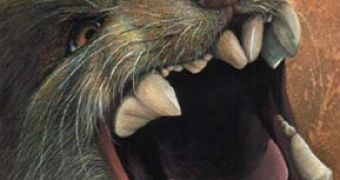Its closest relative were the koala and the wombats. But it was not a leaf lover; instead, it slew extinct cow-sized kangaroos and hippo-sized Diprotodons. The extinct Australian marsupial lion (Thylacoleo carnifex) was the largest carnivorous marsupial mammal ever and a new research published in the Journal of Zoology shows that at the same weight, this animal would have killed a modern African lion (Panthera leo) in a fight.
The new study points that Thylacoleo killed its victims very quickly, penetrating with its "bolt-cutter" teeth through hide and flesh of large animals, causing huge wounds and blood loss. Instead, African lions and the other big cats employ their bite force to suffocate prey, and the method can require up to 15 minutes for large mammals, like Cape buffalo.
"My results suggest that the marsupial lion employed a unique killing technique. It used its massive carnassial cheekteeth to effect major trauma and a rapid kill. Unlike any living mammalian carnivores, the marsupial's carnassials were not only butchery tools but also active components in the killing process," author Stephen Wroe said.
Wroe employed finite element (FE) analysis to create computer dynamic 3D models of the marsupial's skull mechanics and musculoskeletal architecture, using CT scans of its fossil skulls. The results revealed that the skull, jaw, and head and neck muscles of Thylacoleo were evolved for the tearing technique of killing killing large prey, but could not stand prolonged suffocating "clamp and hold" of the large felines.
"The marsupial lion also had an extremely efficient bite. In addition to very powerful jaw muscles for its size, its muscle and skull architecture were arranged in such a way as to take greater advantage of leverage than in living cats. There is now no doubt that Australia's marsupial lion was a fearsome predator that punched well above its weight," Wroe added.
"These new findings support the conclusion that the creature regularly preyed on relatively large species and was able to effect quick kills and withstand large forces generated by large struggling prey. Hypothetically, had a large marsupial lion ever come face to face with an African lion of similar size, it could have use its deadly cheek teeth and incredibly powerful arms to inflict mortal wounds on the (placental) mammal," Wroe concluded.

 14 DAY TRIAL //
14 DAY TRIAL //